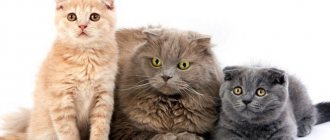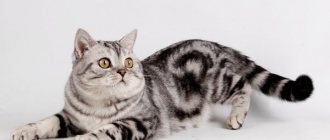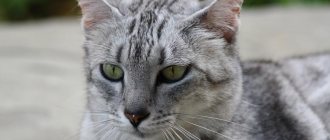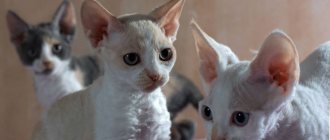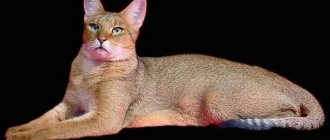The peculiarity of the Scottish Fold cat lies in the shape of its ears, which is not characteristic of other cats; it was once considered a defect, greatly transformed the animal and became the impetus for the creation of a new breed. It was formed with the participation of British and American Shorthair cats.
Not all world organizations enthusiastically accepted the breed with such non-standard ears. Only the CFA and WCF recognized Scottish Fold cats as a test breed in 1974, and four years later, at an elite exhibition in the USA, animals of this breed were met with rave reviews from felinologists and ordinary spectators. Since then, these charming cats began to fully participate in various types of exhibitions.
Breed varieties:
- Scottish Straights have a short coat and straight ears;
- Scottish Fold - short-haired with drooping ears;
- Highland Folds have long fur and ears close to the head.
- Highland Straights are long-haired with straight ears.
In addition to their unusual appearance, Scottish cats also have behavioral characteristics. They love to stand in a column on their hind legs. This is done not to attract attention or to see something better, but to warm up the spine. Another feature is their fear of heights, so they definitely won’t climb on cabinets or hang on curtains; these cats choose more aristocratic methods for their entertainment.
[advertising]
Description of breed standards:
- the body is of medium size, well-developed muscles, the maximum weight of a female is 4-5 kg, a male is 8-10 kg;
- the neck is short and strong;
- the legs are massive, the paws are oval-shaped;
- the tail is short and wide, tapering towards the tip;
- the head is spherical in shape with large plump cheeks, a massive chin and a flattened, humped nose;
- the ears are small, adjacent to the head, rounded at the ends;
- the eyes are large and set wide apart;
- The fur is thick and plush.
Kittens are born with straight ears. Only when they reach the age of 4-5 months can they change their shape and lie on their heads. The shape of their pressing to the head can also be different. Single, double or even triple folding of the ears stands out. The most valuable and expensive of all is the Scottish Fold cat, which has a triple fold of ears that fit snugly to the head, following its contour. Kittens whose ears have not drooped by the time they reach a certain age remain with straight ears for the rest of their lives. The pattern of this process has not yet been clarified, so the number of Scottish Folds in a litter is unpredictable.
Origin story
The history of the Scottish Fold breed began in the mid-20th century in Scotland. On one of the farms, the cat Susie was born: the tips of her ears were curved not up, but down, which gave her face a surprised and funny expression. Susie herself had children like this from time to time. And, quite possibly, they would have remained to live and die on the farm if they had not accidentally caught the eye of a British cat breeder in 1963.
Mary Ross (that was the name of the breeder) immediately realized that this was not just a physical defect, and began to work on a new breed. As a result of mating with a British blue cat and a British shorthair kitten, kittens were born - the first representatives of the Scottish Fold.
A specific gene is responsible for lop ears - Fd. If it is present in both parents, their offspring will face serious problems with the musculoskeletal system and early death. But experimentally it turned out that mating with a Scottish Shorthair - Scottish Straight - allows you to have kittens with desirable external characteristics, but without serious health pathologies.
The Scottish Fold breed was registered in 1994.
What do Scottish Fold cats suffer from?
Scottish Folds are quite healthy. However, there are several diseases that are genetically characteristic of this breed.
- Osteochondrodysplasia (OCD) is a malformation of cartilage and bone tissue, which leads to a slowdown in their growth. This disease is considered incurable, so only supportive therapy is prescribed.
- Polycystic kidney disease (PKD) is a disease in which many hollow tumors with liquid contents (cysts) form in the kidneys. As a result, the affected organs do not fully perform their function.
- Cardiomyopathy is a disease in which the normal functioning of the heart muscle is disrupted.
Also, Scottish Fold cats can suffer from diseases that are typical for most purring pets. These include problems with the genitourinary system, skin and other diseases.
Find out the secret
